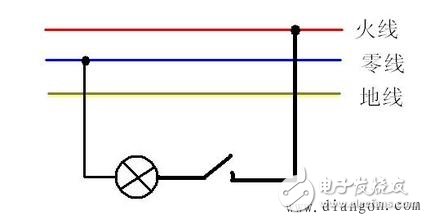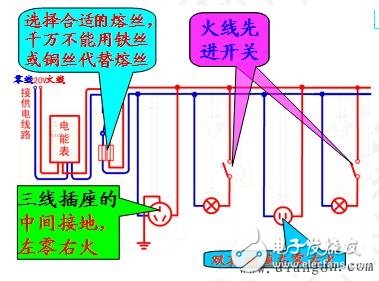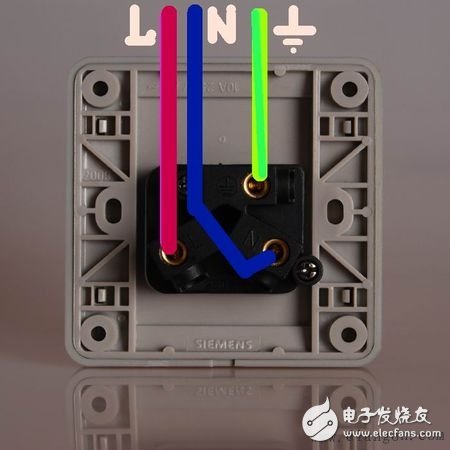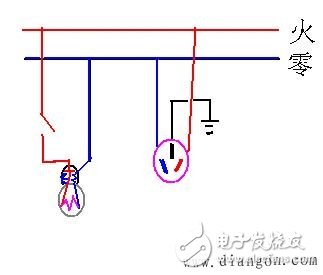First of all, you need to know why electricity is divided into live wires. "Also called phase line", zero line, "also called neutral line" and ground line. "Also called the Protection Line" came from there. What are the roles of each.
Everyone knows that electricity comes naturally from generators. Generators are divided into single-phase generators and three-phase generators. Nowadays, three-phase generators are basically used in power plants. Basically, single-phase "except emergency generators" is no longer needed.
In general, red is the live wire, blue is the zero wire, and black is the ground wire.
The difference between live wire and neutral wire
The live wire and the neutral wire are both live wires. If the two-phase power supply is connected to an electrical appliance, then there will be current flowing through the wire
It is generally felt that the live wire is electrified, because if a person touches (including some indirect contact) the live wire, part of the current passes through the person's body. It is like a water pipe with a tap in the middle. The neutral line is not live because the other end of the power supply (the neutral line) is connected to the ground. When we touch the neutral line on the ground, because there is no potential difference, no current will be formed. So there is a feeling that the neutral line is not charged. The neutral wire and the live wire are originally from the power source, and the positive direction of the current is from one end, passing through the external equipment, and entering from the other end. Form a loop. The difference between the neutral wire and the live wire is that one of the two terminals of the power supply is connected to the ground
The difference between neutral and ground
1. The zero line and the ground line are different concepts, not the same thing.
2. The ground potential of the ground wire is zero. The nearest point of the electrical appliance used is grounded.
3. The ground potential of the neutral line is not necessarily zero. The nearest grounding point of the neutral line is at the substation or the power supply transformer.
4. The neutral line sometimes calls people, when? When your electric stove is not heating up, don't think that it is out of power and can't electric people, wrong! There may be such a possibility that the n line is disconnected from a very distant place from your electrical appliance. When you measure it with a voltmeter, you will find that the ln line of the electrical appliance is the voltage of the mains!
5. The ground wire will not power people, unless it is a bad situation, the designer does not understand, or the product is messed up!
6. If there is a neutral wire and a ground wire in your circuit, you will find a high withstand voltage capacitor between them.
The above content is organized based on the problems encountered by the students in actual work for reference. If you have any problems, please communicate and correct them in time.
Because the three-phase generator has three identical coils embedded on the stator of the generator. When the rotor is in the prime mover, such as a steam turbine. "Water Turbine" drives the downward cutting of the magnetic induction wire and generates an induced electromotive force in the coil. That is electricity. There are three coils on the stator of a three-phase generator, so three-phase electricity is generated. If a load is connected to each coil of a three-phase generator, then three independent and single-phase circuits will be produced. It constitutes a three-phase six-wire system. If this is the case, I need six wires to transmit electricity, which is not economical and has no practical value. But our current low-voltage power supply system mostly uses three-phase four-wire power supply. The three-phase four-wire is to connect the ends of the three coils of the generator together to become a common end "It is called the neutral point. This is why people call the neutral line the neutral line." The transmission line from the neutral line Called the neutral line, the neutral line is usually connected to the earth, and the earth and the neutral point are called the zero point. Always maintain the zero status with the phase line "This is why people call the neutral line the zero line."

the first. After the generator of the power plant is pressurized by the substation, it enters the factory or the electricity consumption place through the transmission grid and then enters the load after the transformer is stepped down. "Electrical appliances" are generally three-phase four-wire ready-to-use lines The color is represented as yellow. Green. Red and Blue "Yellow. Green. Red is the phase wire, blue is the neutral wire and the zero wire.†It is expressed in subtitles as ABC and N. But now the country advocates the use of a three-phase five-wire system in new factories, that is, adding a ground wire to the original four wires. "It is not from the power plant, but in places where electrical appliances are used, such as residential buildings, the country must have a grounding wire to add it by itself. The main function is to lead the electricity into the earth when the equipment leaks to prevent the human body from getting an electric shock. "It is also called the PE wire and the yellow-green color wire
second. Among the five wires, the neutral wire "zero wire" and the ground wire have no voltage. The voltage of the other three wires is generally 400V for any two wires between the wires. There is a voltage drop called line voltage" between the line and the neutral line is 230V "that is, any two lines between ABC and N are actually about 225V are called phase voltage".
The third ground wire is also called a protection wire. Then why call it a protection line. You think that many of the household appliances or factory equipment at home are made of metal. So if there is a leakage in my electrical appliances or equipment, then my electrical appliances or equipment will be live? If someone touches it, does it cause an electric shock? Isn't it dangerous? So is there a way to avoid electric shock accidents when my electrical appliances or equipment leaks? Have! The grounding wire is a good protection method. Why people get electrocuted. First, people are electrical conductors, and second, because there is current flowing through them. Why is there current flow. Because there is voltage. I think you should know Ohm's law? I=U/R That is to say, the larger the resistance, the smaller the current under the same voltage! Another characteristic of the current is that the resistance there is low and it goes there. The resistance of the human body is generally 1700 ohms. Then if the resistance of the ground wire is only 4 ohms, you can see that most of the current will go there. If there is no current flowing, the person will not get an electric shock, right? In fact, to put it bluntly is just one sentence. That is, the function of the grounding wire is to lead the electricity into the ground to prevent the human body from getting an electric shock when the electrical leakage occurs! This is why people call the grounding wire a protection wire!

Fourth, take a three-phase power supply as an example. If there are three phase wires, one neutral wire and one ground wire. "In the circuit diagram, the subtitles L1, L2, L3 are expressed as ABC three-phase. Use N to represent the neutral or neutral line. Use PE for grounding wire
That is the three-phase five-wire system, which is commonly referred to as the TN-S system. That is, the neutral line "Neutral line N" and the protection line "Earth line PE" are separated.
If the three-phase line plus a zero line is a three-phase four-wire system, it is usually called a TN-C system. That is, the neutral line "Neutral Line N" and the protection line "Earth Line PE" are integrated, called PEN line. Usually the protection is connected to zero. Shared PEN line.
The state now advocates the use of TN-S system in newly opened factories. If you use a three-phase five-wire system to connect to a three-phase four-wire system, it depends on your equipment. If you want to use 220V power supply on your equipment, then connect the neutral line "Neutral Line N". Use protection to connect to zero. It is forbidden to use the neutral wire of the ground wire "Neutral wire N". If there is no 220V power supply on the equipment, then connect the grounding wire.
There are two wires in the lighting circuit, one is called the live wire and the other is called the neutral wire. The difference between the live wire and the neutral wire is that they have different voltages to the ground: the voltage to the ground of the live wire is equal to 220V; the voltage of the neutral wire to the ground is equal to zero (it itself is connected to the earth). Therefore, when one part of the person hits the line of fire and the other part stands on the ground, and the voltage between the two parts of the person is equal to 220V, there is a danger of electric shock. On the other hand, even if people grab the neutral line with their hands, if the person is standing on the ground, since the voltage of the neutral line to the ground is equal to zero, the voltage between the various parts of the human body is equal to zero, and there is no danger of electric shock.
If the live wire and the neutral wire touch each other, since the voltage between the two is equal to 220 volts, and the resistance between the two contact points is almost equal to zero, the current is very large at this time, and a huge amount of electricity will be generated at the contact point of the live wire and the neutral wire. Heat, which emits electric sparks, and the temperature of the sparks is high enough to melt the metal wire.

Grounding is the most important job in electrical equipment safety technology and should be taken seriously. The practice of grounding without consideration will often cause undesirable consequences for computer equipment. In severe cases, it will burn down the entire equipment application system and even cause personal injury. Correct grounding can improve the anti-interference ability of the entire system.
Use the power cord of the computer correctly. At present, most of the power sockets we use are single-phase three-wire sockets or single-phase two-wire sockets. In the single-phase three-wire socket, the middle is the ground wire, which is also used for positioning, and the other two ends are connected to the live wire and the neutral wire respectively. The wiring sequence is left and zero, right and right, that is, the left is the neutral wire and the right is the live wire. All household appliances whose shells are made of metal use single-phase three-wire power plugs. The three plugs are arranged in a positive three solution shape, and the longest and thickest copper plug on the top is the ground wire. The two below the ground wire are the live wire (the sign letter is "L" Live Wire) and the zero wire (the sign letter is "N" Naught wire), and the order is left zero and right fire (when the back of the plug is facing you).
Do not connect the neutral terminal and the ground terminal for positioning together during use, because some devices use two-wire plugs. If the power cord and neutral wire of the equipment are connected reversely or plugged in the wrong position during use, it will cause the live wire, The neutral line is short-circuited and the equipment is burned out, causing irreparable losses. Therefore, even if there is no grounding in the three-wire socket in the home or work, it is best to use a three-wire power plug and a three-wire socket.

distinguish:
1. Distinguish by color: In the power cable, yellow, green, and red respectively represent phase A, phase B, phase C (three-phase live wire), blue represents the neutral wire, and yellow and green represent the ground wire.
2. Use the electric pen to distinguish: the live wire will glow when tested with the electric pen, but the zero wire will not.
3. Use a voltmeter to distinguish: the voltage between the different phase wires (ie the live wire) is the line voltage 380V, the voltage between the phase wire (live wire) and the neutral wire (or a good grounding body) is the phase voltage 220V, the neutral wire and The voltage of a good grounding body is 0V.
Power electricity is commonly referred to as 380 volt electricity, which is mostly used in factories. This kind of electricity is mostly three-phase four-wire. Among the four wires, there are three live wires and one zero wire. After the three live wires pass through the load such as electric equipment such as motors, they all pass through the neutral wire to form a loop, and the equipment can work normally. The neutral wire is grounded at the power plant.
Household electricity refers to the 220 volt electricity we often say, also called single-phase electricity, with two wires, one live wire and one neutral wire. After the live wire passes through the load such as a light bulb and other electrical appliances, it forms a loop through the zero wire, and the electrical appliances can work normally. The neutral wire here is also grounded at the power plant.
Although the neutral wires of power and household electricity are grounded in power plants, the ground and neutral wires we usually talk about are not the same concept. Look at the three-hole power socket in our house. If it is properly constructed, one of the holes is the live wire, one is the neutral wire, and the other is the ground wire. The ground wire here is grounded after the whole building is collected. This is the ground wire that is often said. Most household appliances require a grounding wire, which is to be connected to this ground wire.
Why would you get an electric shock?
Some people mistakenly think that the neutral wire is the ground wire, and connect the ground of the household appliance with the neutral wire. Then the live wire forms a loop with the neutral wire and also forms a loop with the shell of the household appliance, so that the shell is charged, especially on the neutral wire. It is easier to get an electric shock when the power socket is not well grounded due to the fault being disconnected.
1. Neutral line: In household electricity, the neutral line usually refers to the line drawn from the grounding body of the transformer. Its connection resistance has strict regulations and must be less than or equal to 0.5 ohms, so as to ensure the normal use of electrical equipment;
2. Live wire: It is relative to the neutral wire. Usually, household electricity only uses one phase of the three-phase electricity, and its line voltage is 220 volts, which makes the household appliances work through the neutral wire forming a loop;
3. Ground wire: The wire we connect to household appliances is usually the ground wire for safety and elimination of static electricity. It does not have strict requirements on the grounding resistance, usually relatively large, and the voltage to the ground is zero when no current passes through. , Using it as the neutral line of electrical appliances cannot make the equipment work normally;
4. Neutral line: It is the line that connects the metal shell of the electrical equipment with the ground wire of the power supply (generator and transformer) as a metal. It requires the fuse or air switch in the line of power supply to the electrical equipment. When electrical equipment touches the shell, the circuit can be disconnected in the shortest time, thus protecting the safety of equipment and life;
5. The socket in the home is not a three-phase socket but a three-wire socket. The middle of it is a grounding wire, and the two sides are used to connect the neutral wire and the live wire. Although the electrician’s manual also has regulations on the right and left fire, but we are in real life The requirements are not so strict.
There are two wires in the lighting circuit, one is called the live wire and the other is called the neutral wire. The difference between the live wire and the neutral wire is that they have different voltages to ground: the live wire to ground voltage is 220V, and the neutral wire to ground voltage is 0.
The ground wire is the ground wire
There is no middle line in the electrician
The home is generally a three-hole socket instead of a three-phase socket, the middle is the grounding wire, and the two sides are live and neutral
The home is generally a three-hole socket instead of a three-phase socket, the middle is the ground wire, the two sides are live and neutral, the right is the live (L), and the left is the neutral (N).
The difference between the live wire and the neutral wire is that they have different voltages to ground: the live wire to ground voltage is 220V, and the neutral wire to ground voltage is 0.
The neutral line is the line drawn from the neutral point of the generator or power transformer. If it is not grounded, it is called the neutral line. If it is well grounded (the earth is at zero potential), the neutral line at this time is also called the neutral line. Although the neutral and ground wires of civil electricity are all drawn from the same point, their respective functions are separate and cannot be mixed. For example, the neutral wire and the live wire are loop wires that use electricity. They are connected to the shell of the electrical appliance. The current flowing in the wire is the same size, so the wire diameter is the same thickness. The ground wire is connected to the outer shell of the electrical appliance. When the electrical appliance is faulty, there is current flowing. Generally, there is no current, so the wire diameter is much thinner. The neutral wire and the live wire are circuits that use electricity, so you must never connect the neutral wire to the shell, as it may cause electric shock.
Ground wire, neutral wire and live wire: The ground is a good conductor, and the ground wire is short-circuited to the ground through a deeply buried electrode. The transmission of the mains power is in a three-phase way, and there is a neutral line. When the three-phase is balanced, the current of the neutral line is zero, commonly known as the "neutral line". Another feature of the neutral line is that it is combined with the ground line in the system. The electrical input is short-circuited and the voltage difference is close to zero. The three phase wires and the neutral wire of the three-phase electricity have 220 voltage, which will cause electric shock to people, commonly known as "fire wire". There are strict standards for the installation and arrangement of electrical circuits. In practice, the correct assembly of the ground, neutral and live wires according to the standards is essential to safety.
English words for live, ground, and neutral
Above is the Earth Wire, "E"
The next two terminals are Naught Wire, "N"
Live wire, "L".
Alternating current is not a special requirement, no matter how hot it is
International standards:
Red is the live wire, black is the neutral wire, and the pattern is the ground wire. All major manufacturers and standardized products follow this principle. Although the live wire and the neutral wire can be interchanged, it is not recommended.
Lvds Connector,Solder Type Lvds Connector,51Pin Stand-Up Lvds Connector,Reclining Paste 51Pin Lvds Connector
Shenzhen CGE Electronics Co.,Ltd , https://www.cgeconnector.com